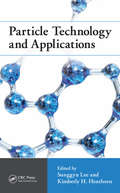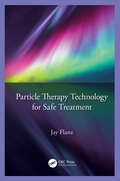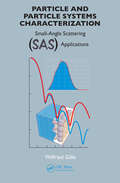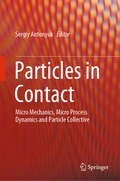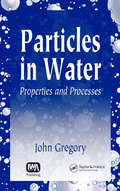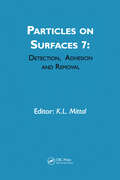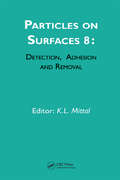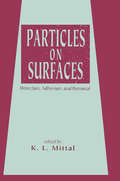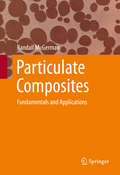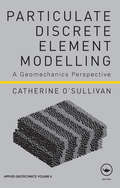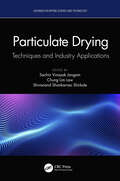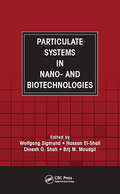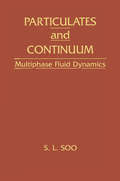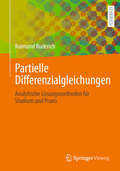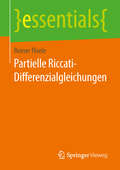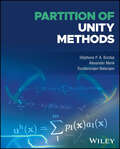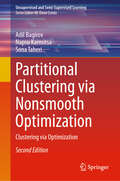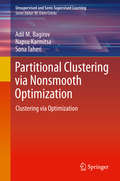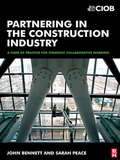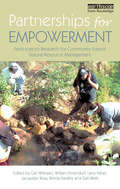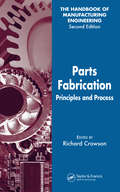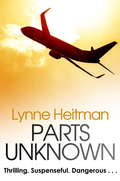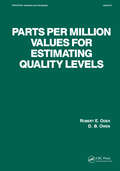- Table View
- List View
Particle Strengths: Extreme Value Distributions in Fracture
by Robert F. CookParticle Strengths A holistic and straightforward analysis framework for understanding particle strength distributions In Particle Strengths: Extreme Value Distributions in Fracture, distinguished researcher Dr. Robert F. Cook delivers a thorough exploration of the science and related engineering of fracture strength distributions of single particles tested in diametral compression. In the book, the author explains particle strengths in the broader context of material strengths to permit readers to design with particles in systems in which mechanical properties are crucial to application, manufacturing, and handling. Particle Strengths compiles published data on particle strengths into a common format that includes over 140 materials systems and over 270 published strength distributions derived from over 13000 individual particle strength measurements. It offers physically consistent descriptions of strength behavior, including the strength threshold, using simple polynomial distribution functions that can easily be implemented. Readers will also find: A thorough introduction to particles and particle loading, including discussions of particle failure and human activity Comprehensive explorations of stochastic scaling of particle strength distributions, including concave and sigmoidal stochastic distributions Practical discussions of agglomerate particle strengths, including those relevant to pharmaceuticals, foods, and catalysts Detailed treatments of applications and scaling of particle strengths, including particle crushing energy and grinding particle reliability Perfect for materials scientists and engineers, mining and construction engineers, and environmental scientists, Particle Strengths: Extreme Value Distributions in Fracture will also benefit anthropologists, zoologists, pharmaceutical scientists, biomaterials scientists and engineers, and graduate students studying materials science, and chemical, mechanical, and biomedical engineering.
Particle Technology and Applications (Green Chemistry and Chemical Engineering)
by Sunggyu Lee Kimberly H. HenthornParticle Technology and Applications presents the theoretical and technological background of particle science and explores up-to-date applications of particle technologies in the chemical, petrochemical, energy, mechanical, and materials industries. It looks at the importance of particle science and technology in the development of efficient chemi
Particle Therapy Technology for Safe Treatment
by Jay FlanzThe path from clinical requirements to technical implementation is filtered by the translation of the modality to the technology. An important part of that filter is that the modality be safe. For that to be the case, it is imperative to understand what clinical parameters affect the safety of a treatment and then determine how the technology can affect those parameters. This book provides a practical introduction to particle therapy. It provides a thorough introduction to the technological tools and their applications and then details the components that are needed to implement them. It explains the foundations of beam production and beam delivery that serve to meet the necessary clinical requirements. It emphasizes the relationship between requirements and implementation, including how safety and quality are considered and implemented in the solution. The reader will learn to better understand what parameters are important to achieve these goals. Particle Therapy Technology for Safe Treatment will be a useful resource for professionals in the field of particle therapy in addition to biomedical engineers and practitioners in the field of beam physics. It can also be used as a textbook for graduate medical physics and beam physics courses. Key Features Presents a practical and accessible journey from application requirements to technical solutions Provides a pedagogic treatment of the underlying technology Describes how safety is to be considered in the application of this technology and how safety and quality can be factored into the overall system Author Bio After receiving his PhD in nuclear physics, Dr. Jacob Flanz was the Accelerator Physics Group leader and Principal Research Scientist at the Massachusetts Institute of Technology (MIT), USA, where he designed the recirculator and the GeV stretcher/storage ring. He joined Massachusetts General Hospital (MGH) and Harvard and became project and technical director of proton therapy, with responsibility for specifications, integration, and commissioning ensuring safe clinical performance. He invented the universal nozzle and led the design and implementation of beam scanning at MGH in 2008, including quality assurance. Dr. Flanz has been involved in several FDA applications for particle therapy. He developed and taught the US Particle Accelerator School course "Medical Applications of Accelerators and Beams." He was cochair of education and is currently the president of the Particle Therapy Co-Operative Group.
Particle and Particle Systems Characterization: Small-Angle Scattering (SAS) Applications
by Wilfried GilleSmall-angle scattering (SAS) is the premier technique for the characterization of disordered nanoscale particle ensembles. SAS is produced by the particle as a whole and does not depend in any way on the internal crystal structure of the particle. Since the first applications of X-ray scattering in the 1930s, SAS has developed into a standard metho
Particles in Contact: Micro Mechanics, Micro Process Dynamics and Particle Collective
by Sergiy AntonyukThis book contains the latest scientific findings in the area of granular materials, their physical fundamentals and applications in particle technology focused on the description of interactions of fine adhesive particles.In collaboration between physicists, chemists, mathematicians and mechanics and process engineers from 24 universities, new theories and methods for multiscale modeling and reliable measurement of particles are developed, with a focus on:• Basic physical-chemical processes in the contact zone: particle-particle and particle-wall contacts,• Particle collisions and their dynamics• Constitutive material laws for particle systems on the macro level.
Particles in Water: Properties and Processes
by John GregoryBased on the author‘s more than 35 years of experience, Particles in Water: Properties and Processes examines particles and their behavior in water systems. The book offers clear and accessible methods for characterizing a range of particles both individually and as aggregates. The author delineates the principles for understanding particle
Particles of Truth: A Story of Discovery, Controversy, and the Fight for Healthy Air
by C. Arden Pope III Douglas W. DockeryA compelling, real-life account of how scientists uncovered air pollution&’s deadly impact on human health—and the contentious battles to use key scientific evidence in the critical fight for clean air.Particles of Truth is a riveting account of the discovery of the critical health effects of air pollution told by Arden Pope and Douglas Dockery, who have been at the forefront of air pollution and health research for four decades. With an insightful foreword by former EPA Administrator Gina McCarthy, this compelling book provides an inside look at groundbreaking scientific research and ensuing political and public-policy battles. It presents evidence that air pollution is a major contributor to disease and death and that reducing air pollution saves lives. The book also delves into intense efforts to discredit and cast doubt on the science.Through firsthand accounts, Pope and Dockery bring the scientific discoveries regarding the health effects of air pollution and accompanying controversies to life. They describe the real-world challenges of conducting impactful research when public health clashes with economic interests and politics. Despite these challenges, they and their colleagues persisted, accumulating evidence that supports landmark clean-air legislation and pollution reduction efforts worldwide. More than an inside look at pioneering air pollution research and the hidden health burden of air pollution, Particles of Truth is a story of determination and perseverance by those working to protect air quality and our health; indeed, their efforts have contributed to improvements in public health and an increase in longevity. For anyone interested in public health, environmental quality, or public policy, this is a must-read book that takes you to the front lines of discovery and controversy.
Particles on Surfaces: Detection, Adhesion And Removal
by K. L. MittalThis volume documents the proceedings of the 7th International Symposium on Particles on Surfaces: Detection, Adhesion and Removal held in Newark, NJ, June 19-21, 2000. The study of particles on surfaces is extremely important in a host of diverse technological areas, ranging from microelectronics to optics to biomedical. This volume contains a total of 28 papers, which were all properly peer reviewed, revised and edited before inclusion. Therefore, this book is not merely a collection of unreviewed manuscripts, but rather represents information which has passed peer scrutiny. Furthermore, the authors were asked to update their manuscripts, so the information contained in this book should be current and fresh. This volume is divided into two parts: 1) Particle Analysis and General Cleaning-Related Topics; and 2) Particle Adhesion and Removal. The topics covered include: surface analysis techniques for particle identification; cleaning, rinsing and drying issues in post-CMP cleaning; fundamental forces involved in particle adhesion; factors affecting adhesion of small (nanosize) particles; factors important in particle detachment; particle adhesion measurement by AFM; various (wet and dry) techniques for particle removal, e.g., laser, ultrasonic, megasonic, use of surfactants; toner particles and pharmaceutical particles. This volume offers a wealth of information on the tremendously technologically important field of particles on surfaces and should provide a consolidated source of current R&D activity in this arena. Therefore, it will be of value and use to anyone interested in the topic of particles on surfaces.
Particles on Surfaces: Detection, Adhesion and Removal, Volume 8
by K. L. MittalThis volume documents the proceedings of the 8th International Symposium on Particles on Surfaces: Detection, Adhesion and Removal held in Providence, Rhode Island, June 24a 26, 2002. The study of particles on surfaces is extremely crucial in a host of diverse technological areas, ranging from microelectronics to optics to biomedical. In a world o
Particles on Surfaces: Detection: Adhesion, and Removal
by K. L. MittalThis work comprises the proceedings of the Fourth Symposium on Particles on Surfaces. Papers cover: adhesion-induced deformations of particles on surfaces; the use of atomic force microscopy in probing particle-particle adhesion; particle contamination in microelectronics, on spacecraft, and on optical surfaces; the role of air ionization in reducing surface contamination by particles in the cleanroom; abrasive blasting media for contamination-free deburring processes; and more.;The book is intended for physical, chemical, surface and colloid chemists, materials scientists; polymers, plastics, electrical and electronics, computer, chemical and mechanical engineers; and upper-level undergraduate and graduate students in these disciplines.
Particulate Composites
by Randall M. GermanThis book is focused on composites involving powders as the starting materials. It provides relevant information for questions related to the selection of constituent phases, most economic fabrication routes, proper testing procedures, and product optimization. The field is sufficiently advanced that predictive models guide many decisions. Applications are illustrated over a broad range of material and property combinations. This title includes: *Selection of phases with consideration of intersolubility & interface *Microstructure, especially the role of phase connectivity *Fabrication approaches, especially net-shape consolidation *Assessment of typical properties, testing techniques & industry standards *Design & trade-off decisions involved in optimization, including cost *Applications, both those that have matured and some emerging prospects. The reader may have little appreciation for how particulate composites are literally everywhere. Examples include new wear resistant consumer products(Apple watch), longer lasting automotive tires with reduced rolling resistance(Yokohama tires), and new diamond heat sinks for computers(Element Six substrates). Particulate composites also form critical components in applications such as magnets, dental fillings, brakes, darts, bio-implants, & cutting tools. Particulate composites are a multi-billion dollar industry, and can be a cost-effective solution ripe for innovation and continued rapid growth. For the engineer, the wide range of particulate composite formulation and property combinations offers the ability to design for a variety of application and provides ample opportunity for innovation. Particulate Composites: Fundamentals & Applications is ideal for use in a one-semester eng. course at the senior UG/graduate level, and is also suitable as a practical reference for materials scientists in academia and industry.
Particulate Discrete Element Modelling: A Geomechanics Perspective (Applied Geotechnics)
by Catherine O'SullivanThe first single work on DEM providing the information to get started with this powerful numerical modelling approach. Provides the basic details of the numerical method and the approaches used to interpret the results of DEM simulations. It will be of use to professionals, researchers and higher level students, with a theoretical overview of DEM as well as practical guidance.Selected Contents: 1.Introduction 2.Use of DEM in Geomechanics 3.Calculation of Contact Forces 4.Particle Motion 5.Particle Types 6.Boundary Conditions 7.Initial Geometry and Specimen Generation 8.Time Integration and Discrete Element Modelling 9.DEM Interpretation: A Continuum Perspective 10.Postprocessing: Graphical Interpretation of DEM Simulations 11.Basic Statisti
Particulate Drying: Techniques and Industry Applications (Advances in Drying Science and Technology)
by Sachin Vinayak Jangam Chung Lim Law Shivanand Shankarrao ShirkoleIn the process industry, understanding the unit operation of particulate drying is imperative to yield products with desired properties and characteristics and to ensure process safety, optimal energy efficiency and drying performance, as well as low environmental impact. There are many techniques and tools available, which can cause confusion. Particulate Drying: Techniques and Industry Applications provides an overview of various particulate drying techniques, their advantages and limitations, industrial applications, and simple design methods. This book: • Covers advances in particulate drying and their importance in the process industry • Highlights recent developments in conventional drying techniques and new drying technologies • Helps readers gain insight into selecting the appropriate drying techniques for a particular product • Summarizes various applications from a wide range of industries, including chemical, food, pharmaceutical, biotech, polymer, mineral, and agro-industries • Projects future research trends and demands in particulate drying This book serves as a reference for process and plant engineers as well as researchers in the fields of particulate processing, mineral processing, food processing, chemical engineering, and mechanical engineering, especially those involved in the selection of drying equipment for particulate solids and R&D of drying of particulate materials.
Particulate Systems in Nano- and Biotechnologies
by Brij M. Moudgil Wolfgang Sigmund Hassan El-Shall Dinesh O. ShahDespite the widespread growth and acceptance of particulate technology, challenges in the design, operation, and manufacturing of these systems still exists. These critical issues must be resolved so that particle technology may continue to serve as a foundation for new nano and biotechnologies. Particulate Systems in Nano- and Biotechnologies pres
Particulates And Continuum-Multiphase Fluid Dynamics: Multiphase Fluid Dynamics
by Shao L. SooTreating multiphase systems with emphasis on the aspect of fluid dynamics and as an introduction to research in multiphase flow, this book covers definitive concepts, methods, and theories which have been validated by experimental results. A textbook for college seniors and graduate students and a research reference, it is a coherent presentation that facilitates the understanding of physical interactions. The book's focus is fluid dynamics, with extension to other transport processes of heat and mass transfer, and chemical relations to illustrate applications of multiphase flow. The exercise problems at the end of each chapter assist the reader in formulating and solving physical problems and gaining a sense of magnitude of interacting effects and events. Extended details and corollaries are also included in these exercise problems. Some of the topics in the exercise problems may also be incorporated as topics for the lectures.
Partielle Differenzialgleichungen: Analytische Lösungsmethoden für Studium und Praxis
by Raimund RuderichDieses Lehrbuch vermittelt das Grundwissen der verschiedenen analytischen Lösungsmethoden partieller Differenzialgleichungen. Zur jeder Methode werden Beispiele detailgenau durchgerechnet, die mit einfachen Erklärungen für Klarheit sorgen. Studierende lernen zielgerichtet diejenige Methode auszuwählen, die am besten zur Problemstellung passt. Als Unterstützung werden Hinweise zum kostenlosen internetbasierten CAS (Computer-Algebra-System) "WolframAlpha" bereitgestellt.
Partielle Riccati-Differenzialgleichungen (essentials)
by Reiner ThieleReiner Thiele leitet die Lösungen partieller Riccati-Differenzialgleichungen her und zeigt den Zusammenhang zwischen allgemeinem Integral und singulärer Lösung auf. Dazu appliziert er eine neue Zerlegungsmethode dieser nichtlinearen Differenzialgleichungen (DGL) in jeweils zwei lineare Gleichungen. Nach der Bestimmung der Eigenwerte liegen die Lösungen vor, die bei Faraday-Effekt-Stromsensoren auftreten und durch eine lineare Beziehung zwischen Messgröße und Messwert gekennzeichnet sind. Praxisrelevante Beispiele für Messgrößen und Messwerte beweisen die große Applikationsbreite der patentierten Faraday-Effekt-Stromsensoren des Autors.Der AutorProf. Dr.-Ing. Reiner Thiele lehrte an der Hochschule Zittau/Görlitz und lehrt an der Staatlichen Studienakademie Bautzen.
Partition of Unity Methods
by Stéphane P. Bordas Alexander Menk Sundararajan NatarajanPARTITION OF UNITY METHODS Master the latest tool in computational mechanics with this brand-new resource from distinguished leaders in the field While it is the number one tool for computer aided design and engineering, the finite element method (FEM) has difficulties with discontinuities, singularities, and moving boundaries. Partition of unity methods addresses these challenges and is now increasingly implemented in commercially available software. Partition of Unity Methods delivers a detailed overview of its fundamentals, in particular the extended finite element method for applications in solving moving boundary problems. The distinguished academics and authors introduce the XFEM as a natural extension of the traditional finite element method (FEM), through straightforward one-dimensional examples which form the basis for the subsequent introduction of higher dimensional problems. This book allows readers to fully understand and utilize XFEM just as it becomes ever more crucial to industry practice. Partition of Unity Methods explores all essential topics on this key new technology, including: Coverage of the difficulties faced by the finite element method and the impetus behind the development of XFEM The basics of the finite element method, with discussions of finite element formulation of linear elasticity and the calculation of the force vector An introduction to the fundamentals of enrichment A revisitation of the partition of unity enrichment A description of the geometry of enrichment features, with discussions of level sets for stationary interfaces Application of XFEM to bio-film, gradient theories, and three dimensional crack propagation Perfect for researchers and postdoctoral candidates working in the field of computational mechanics, Partition of Unity Methods also has a place in the libraries of senior undergraduate and graduate students working in the field. Finite element and CFD analysts and developers in private industry will also greatly benefit from this book.
Partitional Clustering via Nonsmooth Optimization: Clustering via Optimization (Unsupervised and Semi-Supervised Learning)
by Adil Bagirov Napsu Karmitsa Sona TaheriThis updated book describes optimization models of clustering problems and clustering algorithms based on optimization techniques, including their implementation, evaluation, and applications. The book gives a comprehensive and detailed description of optimization approaches for solving clustering problems; the authors' emphasis on clustering algorithms is based on deterministic methods of optimization. The book also includes results on real-time clustering algorithms based on optimization techniques, addresses implementation issues of these clustering algorithms, and discusses new challenges arising from very large data and data with noise and outliers. The book is ideal for anyone teaching or learning clustering algorithms. It provides an accessible introduction to the field and it is well suited for practitioners already familiar with the basics of optimization.
Partitional Clustering via Nonsmooth Optimization: Clustering via Optimization (Unsupervised and Semi-Supervised Learning)
by Napsu Karmitsa Sona Taheri Adil M. BagirovThis book describes optimization models of clustering problems and clustering algorithms based on optimization techniques, including their implementation, evaluation, and applications. The book gives a comprehensive and detailed description of optimization approaches for solving clustering problems; the authors' emphasis on clustering algorithms is based on deterministic methods of optimization. The book also includes results on real-time clustering algorithms based on optimization techniques, addresses implementation issues of these clustering algorithms, and discusses new challenges arising from big data. The book is ideal for anyone teaching or learning clustering algorithms. It provides an accessible introduction to the field and it is well suited for practitioners already familiar with the basics of optimization.
Partnering in the Construction Industry
by John Bennett Sarah PeacePartnering is the most effective way of tackling construction projects. This book explains how clients and construction firms using partnering can achieve ever higher levels of efficiency and certainty to provide world class buildings and infrastructure of all kinds.Detailed guidance about the actions that clients and professionals new to partnering need to take is given followed by advice about the actions individual firms can take to get the maximum benefits from partnering. Finally the book describes how highly developed forms of partnering are developing into strategic collaborative working that turns construction into a genuinely modern industry able to meet all customers’ needs. The book is designed to be used flexibly by a variety of readers, with coloured sections and executive summaries built into the body of the text to enable senior managers to get a quick overview of the guidance provided. The detailed guidance provides those at the workface with the ammunition needed to cooperate with those around them in doing their best work. The guidance is supported by check lists that help ensure everyone involved knows what they need to do to match and then exceed today’s best practice. Construction clients will learn how to get high quality, reliable and fast completion and a firm price that represents best value for money.This book helps everyone in the construction industry be fairly rewarded for delivering best practice. The expert guidance also gives the construction industry the time and resources needed to give proper attention to all aspects of quality including sustainability and total life cycle costs.to match and then exceed today’s best practice.
Partnerships for Empowerment: Participatory Research for Community-based Natural Resource Management
by Carl Wilmsen Larry Fisher Jacquelyn Ross Brinda Sarathy Gail Wells William ElmendorfParticipatory research has emerged as an approach to producing knowledge that is sufficiently grounded in local needs and realities to support community-based natural resource management (CBNRM), and it is often touted as crucial to the sustainable management of forests and other natural resources. This book analyses the current state of the art of participatory research in CBNRM. Its chapters and case studies examine recent experiences in collaborative forest management, harvesting impacts on forest shrubs, watershed restoration in Native American communities, civic environmentalism in an urban neighborhood and other topics. Although the main geographic focus of the book is the United States, the issues raised are synthesized and discussed in the context of recent critiques of participatory research and CBNRM worldwide. The book's purpose is to provide insights and lessons for academics and practitioners involved in CBNRM in many contexts. The issues it covers will be relevant to participatory research and CBNRM practitioners and students the world over.
Parts Fabrication: Principles and Process
by Richard CrowsonToday's fast-paced manufacturing culture demands a handbook that provides how-to, no-holds-barred, no-frills information. Completely revised and updated, the Handbook of Manufacturing Engineering is now presented in four volumes. Keeping the same general format as the first edition, this latest edition not only provides more information but makes i
Parts Unknown: A white-knuckle ride thriller set in the murky world of aviation
by Lynne HeitmanA gripping and fast-paced Alex Shanahan thriller set in the dangerous and murky world of aviation. Perfect for fans of Jeffery Deaver and James Patterson__________Alex Shanahan is on her way to a new job with a Detroit start-up airline when the death of a friend takes her on a detour to Miami. The trip turns deadly when Alex connects this murder to the lucrative world of black-market airplane parts: used parts that are illegally reworked, repainted and sold as new.Now Alex must walk into the darkest corner of the airline business she loves, the sordid underbelly of scavengers and chop shops, where profits are valued over the lives of a planeload of passengers - and murder isn't too far to go when millions are at stake.In a world where one faulty part can bring down an airliner and catastrophe is an acceptable risk, Alex must tread carefully, because every step she takes could be her last . . .__________Book 2 in the Alex Shanahan series.
Parts per Million Values for Estimating Quality Levels (Statistics: A Series of Textbooks and Monographs)
by R. E. OdehThis book is an extension of some tables from Odeh and Owen, Volume 32 of the Marcel Dekker, Inc., series Statistics: Textbooks and Monographs. The need for these tables was pointed out to us by Dr. James M. Maynard, who worked with the Parts Per Million Subcommittee.

